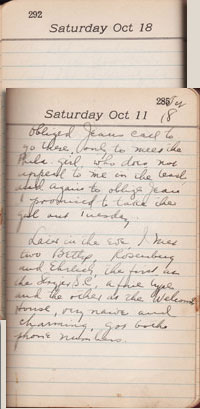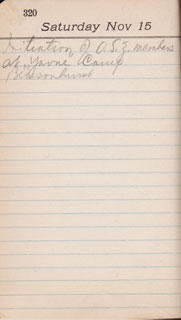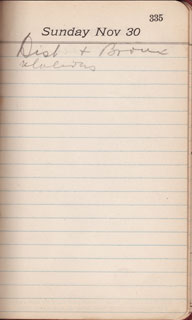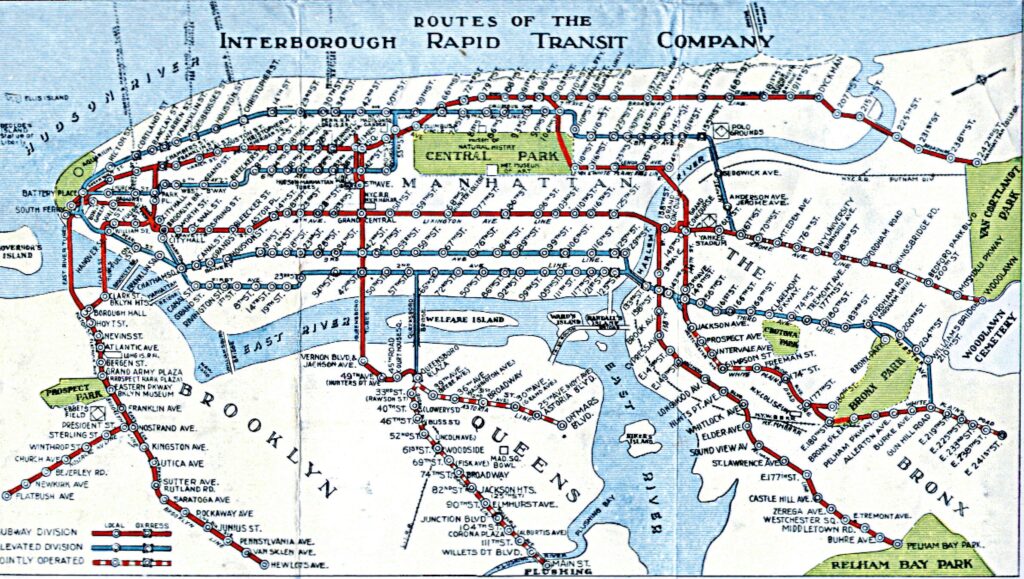
[Note: Papa accidentally wrote his October 18th entry on the October 11th page of his diary. I’ve included thumbnails of both pages at right]
————-
Obliged Jeans call to
go there, only to meet the
Phila. girl, who does not
appeal to me in the least,
and again to oblige Jean
I promised to take the
girl out Tuesday.
Later in the Eve, I met
two Bettys, Rosenberg
and Ehrlich, the first at
the Stoyjer S.C., a fine type
and the other at the Welcome
House, very naive and
charming, got both
phone numbers.
——————
This entry feels a bit like it’s missing a first paragraph. We know “Jean” is a cousin who does double duty as Papa’s personal love counselor, but where’s the “there” Papa goes at her behest? Perhaps his disappointment with “the Phila girl” (is this a girl from Philadelphia, or someone whose last name is Phila?) and his annoyance with Jean for arranging his date got him too keyed up to provide many details, as if he just wanted to get it over with when he set down to write about it.
The two women named “Betty,” on the other hand, both earn adjectives Papa reserves for women he likes (“naive” usually means innocent or sweet, while “a fine type” means the marrying kind) and both warrant descriptions of the time and place he met them. The “Welcome House” was, I think, a Jewish settlement house on East 13th Street, and like many settlement houses offered a combination of residential and social services for the disenfranchised and also served as a gathering place for the civic-minded. Papa may have gravitated to the Welcome House, where he encountered Betty Rosenberg, because it focused on Hungarian immigrants, at least according to this record from a 1911 book called the “Handbook of Settlements” (excerpted below from Google Books):
I’m less clear on where Papa encountered Betty Ehrlich, but only because I can’t make out his writing. It looks like he says he found her at the “Stoyjer S.C.”, but while I’m pretty sure that “S.C.” stands for “Social Club,” I’m also pretty sure that Papa really didn’t write “Stoyjer.” Please drop a comment or note if you read it differently:

I should also note that Betty Ehrlich shares my wife’s last name, though I don’t think I’m about to discover that I’m somehow related to my wife or anything; Ehrlich is not a particularly unusual Jewish name and, in fact, my wife got it from her stepfather. Still, it gave me a jolt to see it in Papa’s handwriting and triggered a momentary, science fiction daydream in which I discover some overlooked part of Papa’s diary addressed specifically to me. As if, as 1924 entered the home stretch, Papa saw me in the distance and wrote down exactly what I needed to know.
————–
Update: Aviva, one of our most loyal readers and contributors of well-researched comments, added a comment below that I don’t want to go unnoticed:
I believe Papa wrote Stryjer, a benevolent club from the shtetl of Stryj. See URL https://www.jewishgen.org/yizkor/stryj2/stre019.html
Strij, as it’s spelled in Google maps, is about 100 miles northeast of Papa’s home town of Sniatyn, and both towns are in what is now known as the Ukraine. It looks like, for whatever reason, Papa spent this evening hitting all of New York’s hot spots for Austro-Hungarian Jews.





